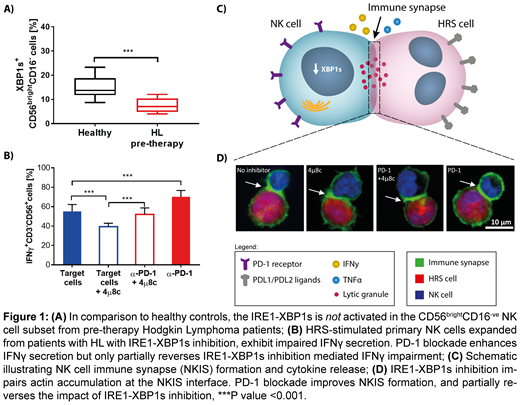Background
The frequent loss of Major Histocompatibility Complex I molecule (MHC-I) on Hodgkin/Reed-Sternberg (HRS)-cells renders them susceptible to Natural Killer (NK) cell-mediated lysis in Hodgkin Lymphoma (HL). Optimal NK cell function involves migration from peripheral blood to sites of disease, formation of an immune synapse (NKIS) between NK cells and HRS cells, and release of effector molecules. We recently showed that PD-1+ NK cells are expanded in the circulation of patients with HL (Vari, F Blood 2018), and that PD-1 blockade enhances their anti-HRS capabilities. However, mechanisms behind the functional impairment of NK cells in HL patients and the impact PD-1 blockade has on NK cell function remain to be established. Although the IRE1-XBP1s pathway, part of the unfolded protein response (UPR) system, has established and fundamental roles in macrophage, B, T and dendritic cells homeostatic function, its involvement in NK cells remains unknown. We hypothesized that IRE1-XBP1s dysfunction contributes to NK cell impairment and tested the impact of PD-1 blockade on individual components of NK cell function, including migration, NKIS formation, and cytokine release.
Methods
Ex-vivo functional assays were performed on blood from 20 participants. Confocal microscopy, time-lapse imaging, trans-well migration, and functional in-vitro immune assays were utilized on a range of NK and HRS cell lines, with and without IRE1-XBP1s small molecule inhibitors (4µ8c and 6-bromo) and/or PD-1 blockade (pembrolizumab).
Results
Stimulation of both NK cell lines and primary NK cells, with HRS lines resulted in marked and rapid IRE1-XBP1s pathway activation. This occurred independently of the canonical UPR and was associated with increased NK cell effector function. However, IRE1-XBP1s pathway inhibition resulted in aberrant NK cell morphology, reduced motility and migration, deficient NKIS formation and impaired interferon-gamma (IFNγ) and tumor necrosis factor alpha (TNFα) release. Next, we tested the IRE1-XBP1s pathway in the pre-therapy blood of patients with HL and compared this with healthy age/gender matched controls. Strikingly, following co-culture with an HRS-line the pathway was not activated, but this abnormality was restricted to the CD56brightCD16-ve subset that we have previously shown to be expanded and enriched in PD-1 (as well as downregulation of the lymphoid migratory chemokine CCR7) in patients with HL. In subsequent experiments using in-vitro expanded populations of primary NK cells from HL patients, IRE1-XBP1s pathway inhibition impaired the migration, NKIS formation, CD107a degranulation, and secretion of IFNγ and TNFα. Effects were partially but not completely restored by addition of PD-1 blockade (Fig 1).
Conclusion
Here, we outline a hitherto unrecognized mechanism involving the IRE1-XBP1s pathway that is pivotal to NK cell function, including the relatively poorly understood processes of migration, NKIS formation, and cytokine secretion. Notably, IRE1-XBP1s pathway activation is dysfunctional within the PD-1 enriched CD56brightCD16- NK cell subset. Although PD-1 blockade appears to have a multi-faceted beneficial role on NK cell migrational/NKIS and cytokine release capabilities, it is still only capable of partial restoration of NK cell effector function. Further understanding of the pathways operative in NK cells may result in improved immunotherapeutic strategies to enhance this arm of the immune response in patients with HL.
Gandhi:Celgene: Membership on an entity's Board of Directors or advisory committees, Research Funding; Gilead: Honoraria, Research Funding; Roche: Honoraria, Other: Travel Support; Janssen: Membership on an entity's Board of Directors or advisory committees, Research Funding; Merck: Membership on an entity's Board of Directors or advisory committees; Amgen: Honoraria; Bristol Myers Squibb: Membership on an entity's Board of Directors or advisory committees, Research Funding.
Author notes
Asterisk with author names denotes non-ASH members.


This feature is available to Subscribers Only
Sign In or Create an Account Close Modal